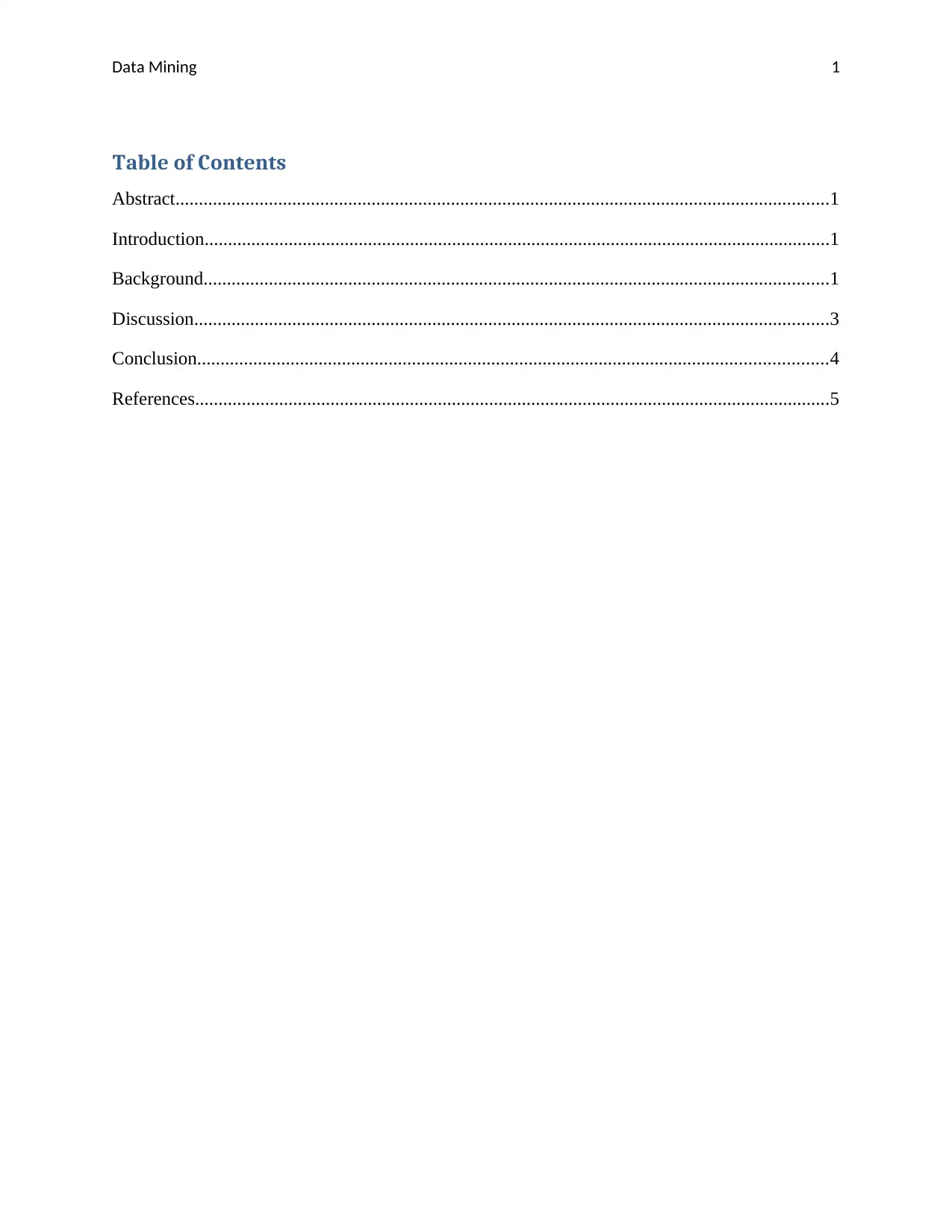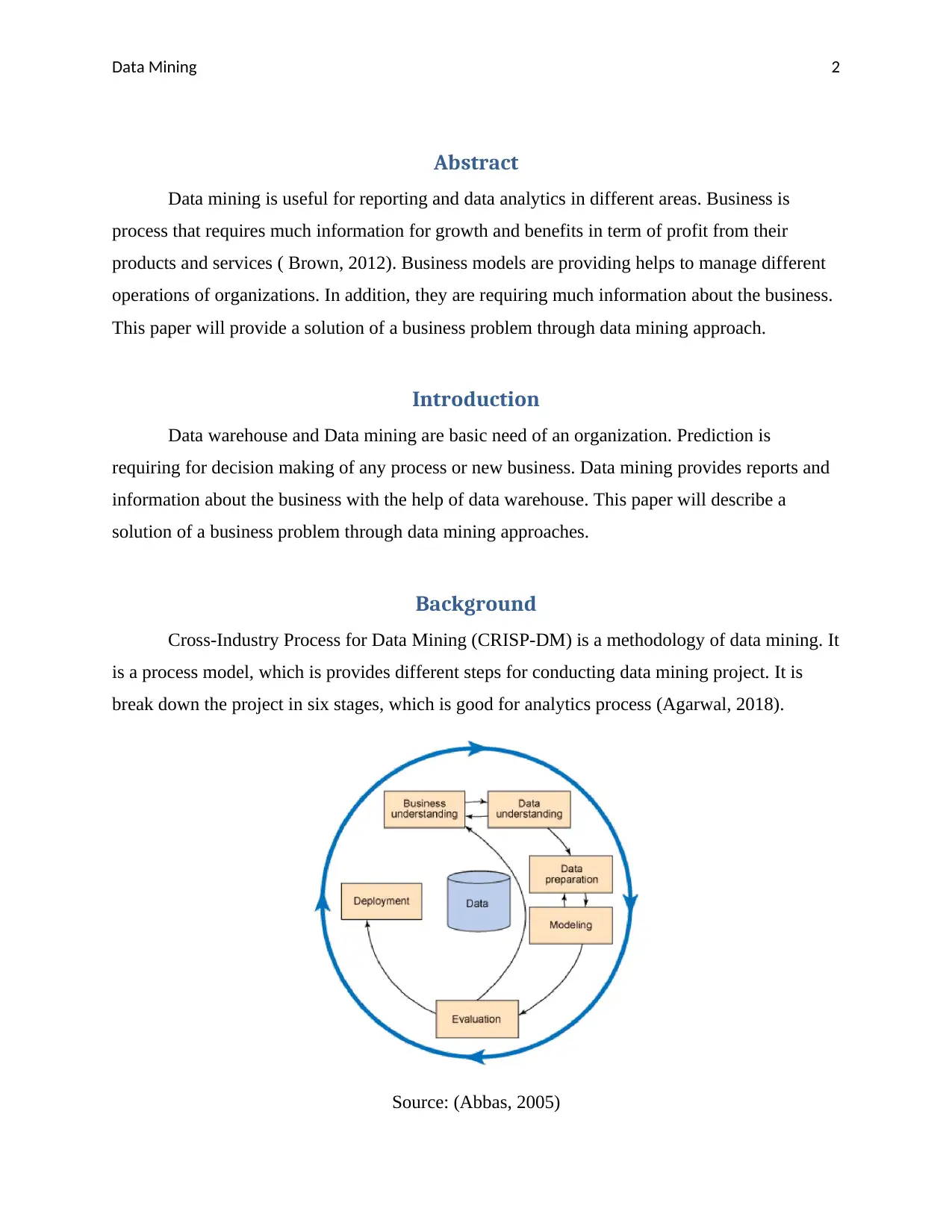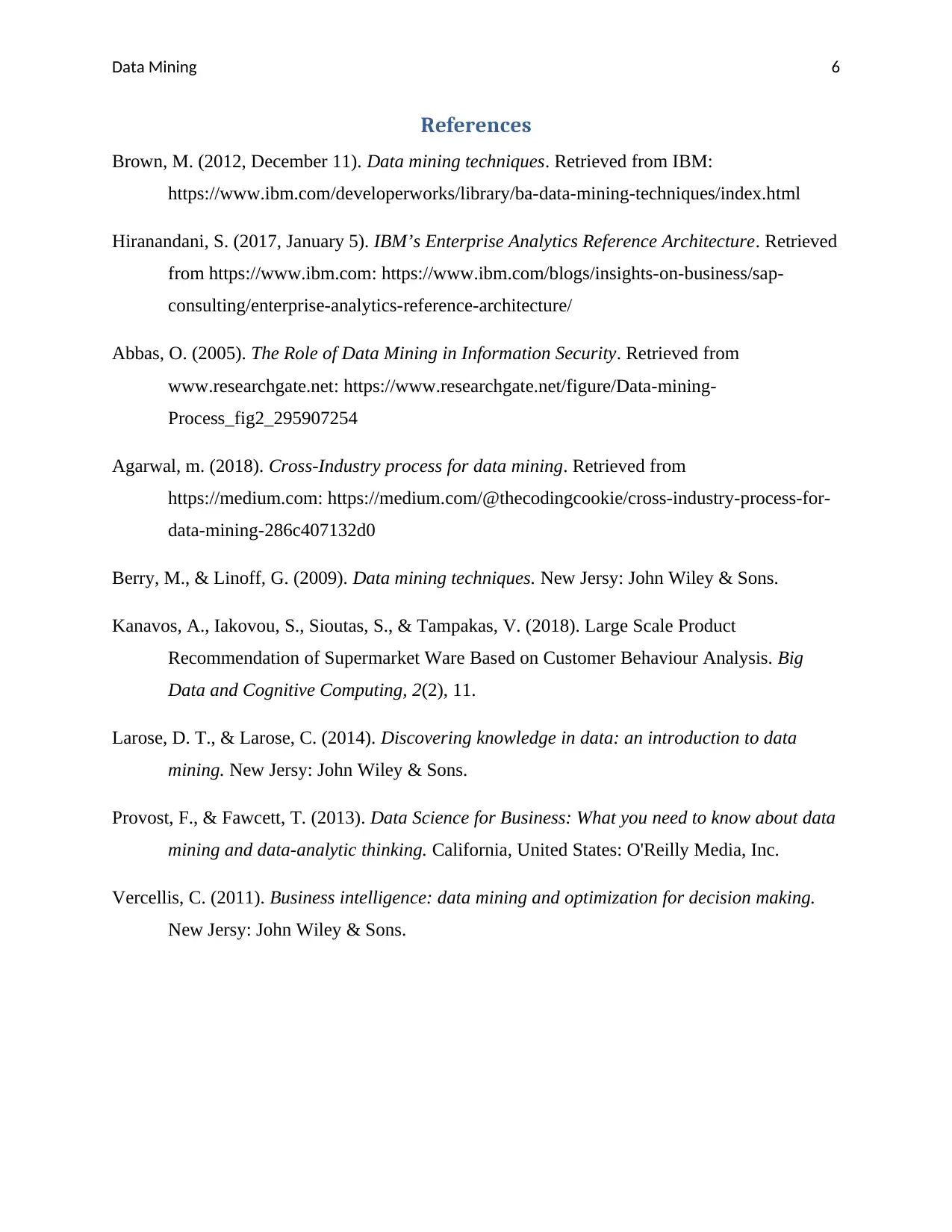Data Mining Report: Data Mining Approach for Supermarket Sales
VerifiedAdded on 2023/04/21
|7
|1117
|413
Report
AI Summary
This data mining report explores the application of data mining techniques to solve a business problem faced by supermarkets. The report begins with an abstract summarizing the benefits of data mining in business and its role in providing crucial information for decision-making. It then introduces the Cross-Industry Process for Data Mining (CRISP-DM) methodology, detailing its six stages: business understanding, data understanding, data preparation, modeling, evaluation, and deployment. The report applies this methodology to a supermarket scenario where the goal is to analyze sales data and identify items with low sales to optimize product selection. Various data mining techniques, including algorithms and customer behavior analysis, are discussed. The report concludes that data mining is a valuable tool for solving business problems, providing insights for decision-making, and ultimately leading to improved business outcomes. References to relevant literature support the analysis and conclusions.

Running Head: DATA MINING 0
Data Mining
Report
Student name
Data Mining
Report
Student name
Paraphrase This Document
Need a fresh take? Get an instant paraphrase of this document with our AI Paraphraser

Data Mining 1
Table of Contents
Abstract............................................................................................................................................1
Introduction......................................................................................................................................1
Background......................................................................................................................................1
Discussion........................................................................................................................................3
Conclusion.......................................................................................................................................4
References........................................................................................................................................5
Table of Contents
Abstract............................................................................................................................................1
Introduction......................................................................................................................................1
Background......................................................................................................................................1
Discussion........................................................................................................................................3
Conclusion.......................................................................................................................................4
References........................................................................................................................................5

Data Mining 2
Abstract
Data mining is useful for reporting and data analytics in different areas. Business is
process that requires much information for growth and benefits in term of profit from their
products and services ( Brown, 2012). Business models are providing helps to manage different
operations of organizations. In addition, they are requiring much information about the business.
This paper will provide a solution of a business problem through data mining approach.
Introduction
Data warehouse and Data mining are basic need of an organization. Prediction is
requiring for decision making of any process or new business. Data mining provides reports and
information about the business with the help of data warehouse. This paper will describe a
solution of a business problem through data mining approaches.
Background
Cross-Industry Process for Data Mining (CRISP-DM) is a methodology of data mining. It
is a process model, which is provides different steps for conducting data mining project. It is
break down the project in six stages, which is good for analytics process (Agarwal, 2018).
Source: (Abbas, 2005)
Abstract
Data mining is useful for reporting and data analytics in different areas. Business is
process that requires much information for growth and benefits in term of profit from their
products and services ( Brown, 2012). Business models are providing helps to manage different
operations of organizations. In addition, they are requiring much information about the business.
This paper will provide a solution of a business problem through data mining approach.
Introduction
Data warehouse and Data mining are basic need of an organization. Prediction is
requiring for decision making of any process or new business. Data mining provides reports and
information about the business with the help of data warehouse. This paper will describe a
solution of a business problem through data mining approaches.
Background
Cross-Industry Process for Data Mining (CRISP-DM) is a methodology of data mining. It
is a process model, which is provides different steps for conducting data mining project. It is
break down the project in six stages, which is good for analytics process (Agarwal, 2018).
Source: (Abbas, 2005)
⊘ This is a preview!⊘
Do you want full access?
Subscribe today to unlock all pages.

Trusted by 1+ million students worldwide

Data Mining 3
1. Business understanding: it is a first step for finding business problem. Based on
business problem, data is collected according to that business problem. It is designed for
two objectives, which are need of customers and important factor, such as constraints.
2. Data understanding: data understanding is a process of data collection that is related to
business problem. In this, few steps are followed, which are collect data, explore data,
verify data quality.
3. Data preparation: Raw data is processed and convert into analytical dataset in a process.
Better quality of data is impact on performance of model. Modeling tools clean the data
through different activities. Data is cleans with the help of different methods, such as
missing value analysis, outlier analysis, sampling, and smoothing.
4. Modeling: it is a part of data mining concepts. Algorithms are applied on the clean data.
It is a way to use machine-learning algorithms for solving business problems. There are
many algorithms of data mining for solving the problem, such as linear regression,
decision tree, logistics regression, KNN, random Forest, and naïve Bayes.
5. Evaluation: evaluate the business model and find the business objective that can provide
help to resolve the business problem.
6. Deployment: deployment phase is determined that how can use the result of data mining.
Deployment can be possible through two ways. First is using traditional method using
schedulers. A second method is using online tools, such as AWS.
Supermarkets are having a problem to sale specific items in their store. Therefore, they just need
information about those products, which are having fewer sales at monthly basis. They want to
replace those items from other items.
Source: (Kanavos, Iakovou, Sioutas, & Tampakas, 2018)
1. Business understanding: it is a first step for finding business problem. Based on
business problem, data is collected according to that business problem. It is designed for
two objectives, which are need of customers and important factor, such as constraints.
2. Data understanding: data understanding is a process of data collection that is related to
business problem. In this, few steps are followed, which are collect data, explore data,
verify data quality.
3. Data preparation: Raw data is processed and convert into analytical dataset in a process.
Better quality of data is impact on performance of model. Modeling tools clean the data
through different activities. Data is cleans with the help of different methods, such as
missing value analysis, outlier analysis, sampling, and smoothing.
4. Modeling: it is a part of data mining concepts. Algorithms are applied on the clean data.
It is a way to use machine-learning algorithms for solving business problems. There are
many algorithms of data mining for solving the problem, such as linear regression,
decision tree, logistics regression, KNN, random Forest, and naïve Bayes.
5. Evaluation: evaluate the business model and find the business objective that can provide
help to resolve the business problem.
6. Deployment: deployment phase is determined that how can use the result of data mining.
Deployment can be possible through two ways. First is using traditional method using
schedulers. A second method is using online tools, such as AWS.
Supermarkets are having a problem to sale specific items in their store. Therefore, they just need
information about those products, which are having fewer sales at monthly basis. They want to
replace those items from other items.
Source: (Kanavos, Iakovou, Sioutas, & Tampakas, 2018)
Paraphrase This Document
Need a fresh take? Get an instant paraphrase of this document with our AI Paraphraser

Data Mining 4
There are section problem for supermarket. Based on the customer’s behavior on
particular item, Supermarket can take decisions for different items. Data mining techniques are
useful for business models as well as business processes (Provost & Fawcett, 2013).
Discussion
Traditional approach is showing in below diagram. It shows prediction for something in
business cases (Berry & Linoff, 2009).
Source: ( Hiranandani, 2017)
There are datasets of few item of supermarket with the customer’s behavior.
There are section problem for supermarket. Based on the customer’s behavior on
particular item, Supermarket can take decisions for different items. Data mining techniques are
useful for business models as well as business processes (Provost & Fawcett, 2013).
Discussion
Traditional approach is showing in below diagram. It shows prediction for something in
business cases (Berry & Linoff, 2009).
Source: ( Hiranandani, 2017)
There are datasets of few item of supermarket with the customer’s behavior.

Data Mining 5
Below graph is showing customers reviews on different items with different ranges of
customers.
Source: (Kanavos, Iakovou, Sioutas, & Tampakas, 2018)
It will beneficial for manager of supermarket to manage different items requirements.
Data warehouse and data mining is helpful for business intelligence (Vercellis, 2011). Data
mining is converting raw data into a fruitful knowledge for business as well as solving business
problems (Larose & Larose, 2014).
Conclusion
It is concluded that data mining is beneficial for solving business problems. Datasets are
providing information for selection of items as well as reduce them form stores. Data mining is a
long process. Therefore, it takes long time in starting. It is also helpful for different business
problem or an organization through data collection and information.
Finally, it is concluded that data mining is a best solution for solving business problems.
It provides better results for decision-making.
Below graph is showing customers reviews on different items with different ranges of
customers.
Source: (Kanavos, Iakovou, Sioutas, & Tampakas, 2018)
It will beneficial for manager of supermarket to manage different items requirements.
Data warehouse and data mining is helpful for business intelligence (Vercellis, 2011). Data
mining is converting raw data into a fruitful knowledge for business as well as solving business
problems (Larose & Larose, 2014).
Conclusion
It is concluded that data mining is beneficial for solving business problems. Datasets are
providing information for selection of items as well as reduce them form stores. Data mining is a
long process. Therefore, it takes long time in starting. It is also helpful for different business
problem or an organization through data collection and information.
Finally, it is concluded that data mining is a best solution for solving business problems.
It provides better results for decision-making.
⊘ This is a preview!⊘
Do you want full access?
Subscribe today to unlock all pages.

Trusted by 1+ million students worldwide

Data Mining 6
References
Brown, M. (2012, December 11). Data mining techniques. Retrieved from IBM:
https://www.ibm.com/developerworks/library/ba-data-mining-techniques/index.html
Hiranandani, S. (2017, January 5). IBM’s Enterprise Analytics Reference Architecture. Retrieved
from https://www.ibm.com: https://www.ibm.com/blogs/insights-on-business/sap-
consulting/enterprise-analytics-reference-architecture/
Abbas, O. (2005). The Role of Data Mining in Information Security. Retrieved from
www.researchgate.net: https://www.researchgate.net/figure/Data-mining-
Process_fig2_295907254
Agarwal, m. (2018). Cross-Industry process for data mining. Retrieved from
https://medium.com: https://medium.com/@thecodingcookie/cross-industry-process-for-
data-mining-286c407132d0
Berry, M., & Linoff, G. (2009). Data mining techniques. New Jersy: John Wiley & Sons.
Kanavos, A., Iakovou, S., Sioutas, S., & Tampakas, V. (2018). Large Scale Product
Recommendation of Supermarket Ware Based on Customer Behaviour Analysis. Big
Data and Cognitive Computing, 2(2), 11.
Larose, D. T., & Larose, C. (2014). Discovering knowledge in data: an introduction to data
mining. New Jersy: John Wiley & Sons.
Provost, F., & Fawcett, T. (2013). Data Science for Business: What you need to know about data
mining and data-analytic thinking. California, United States: O'Reilly Media, Inc.
Vercellis, C. (2011). Business intelligence: data mining and optimization for decision making.
New Jersy: John Wiley & Sons.
References
Brown, M. (2012, December 11). Data mining techniques. Retrieved from IBM:
https://www.ibm.com/developerworks/library/ba-data-mining-techniques/index.html
Hiranandani, S. (2017, January 5). IBM’s Enterprise Analytics Reference Architecture. Retrieved
from https://www.ibm.com: https://www.ibm.com/blogs/insights-on-business/sap-
consulting/enterprise-analytics-reference-architecture/
Abbas, O. (2005). The Role of Data Mining in Information Security. Retrieved from
www.researchgate.net: https://www.researchgate.net/figure/Data-mining-
Process_fig2_295907254
Agarwal, m. (2018). Cross-Industry process for data mining. Retrieved from
https://medium.com: https://medium.com/@thecodingcookie/cross-industry-process-for-
data-mining-286c407132d0
Berry, M., & Linoff, G. (2009). Data mining techniques. New Jersy: John Wiley & Sons.
Kanavos, A., Iakovou, S., Sioutas, S., & Tampakas, V. (2018). Large Scale Product
Recommendation of Supermarket Ware Based on Customer Behaviour Analysis. Big
Data and Cognitive Computing, 2(2), 11.
Larose, D. T., & Larose, C. (2014). Discovering knowledge in data: an introduction to data
mining. New Jersy: John Wiley & Sons.
Provost, F., & Fawcett, T. (2013). Data Science for Business: What you need to know about data
mining and data-analytic thinking. California, United States: O'Reilly Media, Inc.
Vercellis, C. (2011). Business intelligence: data mining and optimization for decision making.
New Jersy: John Wiley & Sons.
1 out of 7
Related Documents
Your All-in-One AI-Powered Toolkit for Academic Success.
+13062052269
info@desklib.com
Available 24*7 on WhatsApp / Email
![[object Object]](/_next/static/media/star-bottom.7253800d.svg)
Unlock your academic potential
Copyright © 2020–2025 A2Z Services. All Rights Reserved. Developed and managed by ZUCOL.





